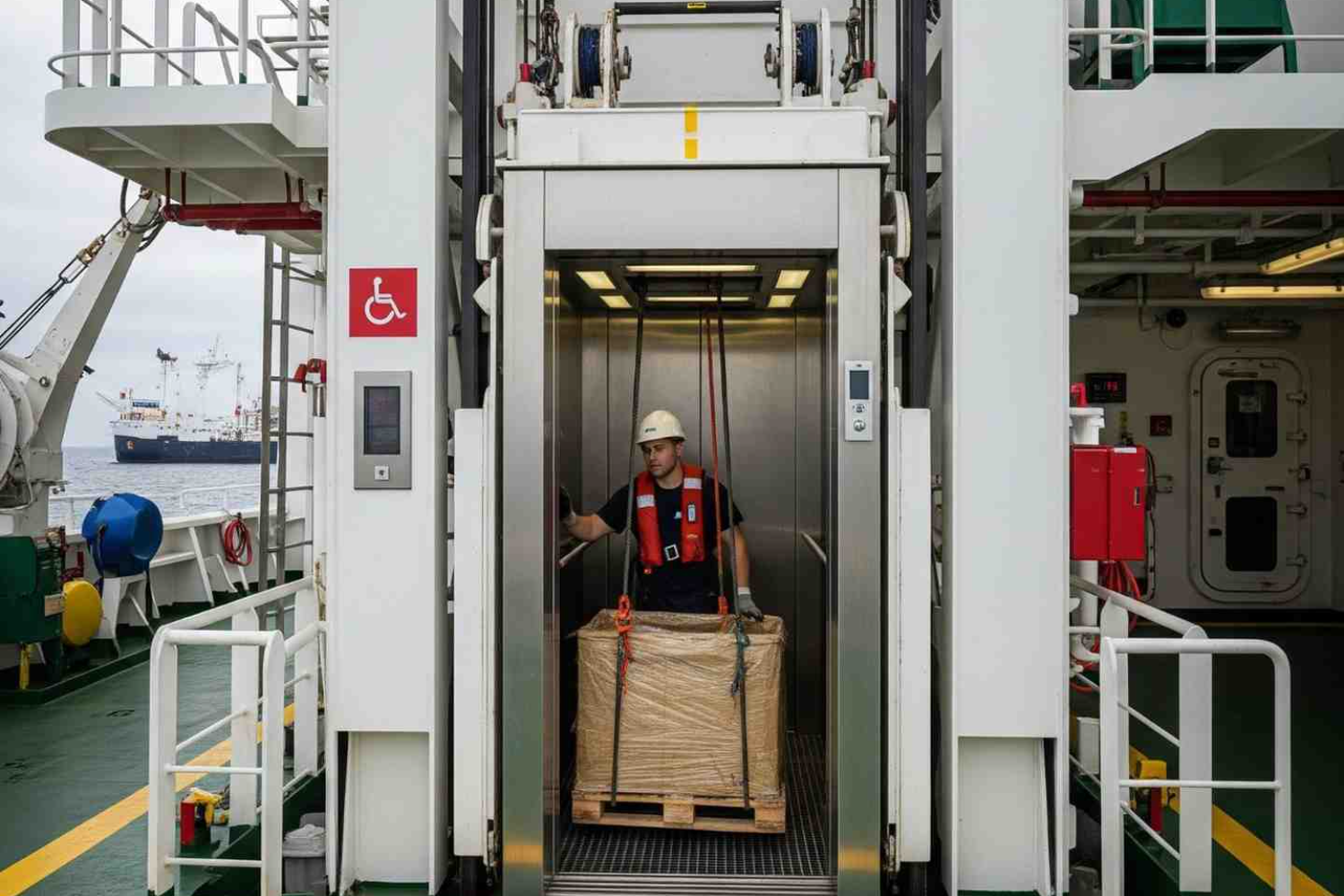
When it comes to marine elevators, two main types are commonly used: hydraulic and electric. Each has its own advantages, functions and most importantly, maintenance requirements. In this blog, we will explain the key differences between hydraulic and electric marine elevators, focusing on how much care and servicing they need over time. Whether you own a ship, manage a yacht or are involved in marine operations in UAE and GCC, understanding the maintenance needs of these elevators can help you make a smart choice. We will walk you through how each system works, the common issues you may face and what kind of regular upkeep is necessary to keep them running smoothly.
What Are Marine Elevators?
Marine elevators are specially designed lifts installed on ships, yachts and offshore platforms. They help move people and goods between decks efficiently and safely, especially when space is limited.
There are mainly two types of marine elevators:
- Hydraulic Marine Elevators
- Electric (Traction) Marine Elevators
Both types work well, but they have different mechanisms and require different kinds of maintenance over time.
Understanding Hydraulic Marine Elevators
Hydraulic elevators work using fluid pressure. A pump pushes hydraulic oil into a cylinder, which lifts the elevator cab. When it goes down, the oil returns to a reservoir.
Key Features:
- Suitable for low to mid-rise marine structures
- Smooth and quiet operation
- Simple technology
- Requires a machine room for the pump and reservoir
Maintenance Requirements:
Hydraulic systems need regular attention to avoid fluid leaks, overheating and corrosion. Some common maintenance needs include:
- Oil checks and replacement: Hydraulic oil can degrade over time and may need to be topped up or changed.
- Seal and hose inspections: Leaks are a common issue. Technicians should regularly inspect hoses and seals.
- Cylinder maintenance: Check for rust, pitting or wear inside the cylinder.
- Pump unit servicing: The motor and pump should be checked for noise, overheating or electrical issues.
- Cleaning of oil tank: Contaminated oil can damage parts and reduce the elevator’s efficiency.
Typical Maintenance Frequency:
- Monthly inspections for oil levels and leaks
- Quarterly servicing for the pump and controls
- Annual deep inspection for major components
Understanding Electric Marine Elevators
Electric elevators (also known as traction elevators) use cables, pulleys and motors to move the elevator cab. These are commonly found in larger vessels or when higher speed and efficiency are needed.
Key Features:
- Faster and more energy-efficient than hydraulic systems
- Requires less fluid handling
- Compact design; no need for a large machine room
- Suitable for taller marine structures
Maintenance Requirements:
Electric elevators need more attention to moving parts like motors and cables. Key maintenance tasks include:
- Motor and drive system checks: Ensure the motor, gear and brakes are functioning correctly.
- Cable inspections: Worn or frayed cables must be replaced immediately.
- Brake testing: Important for safety and must be done regularly.
- Control system updates: The software and electronic systems need updates and inspections.
- Lubrication: Gears and pulleys need proper lubrication to reduce wear and tear.
Typical Maintenance Frequency:
- Monthly checks for cables and motor noise
- Bi-monthly servicing for electrical controls and lubrication
- Annual full inspection of mechanical and software systems
Hydraulic vs Electric: Side-by-Side Comparison
Feature / Factor | Hydraulic Elevator | Electric Elevator |
Power Efficiency | Less efficient | More energy-efficient |
Installation Cost | Lower | Higher |
Maintenance Complexity | Moderate | More complex |
Noise Level | Quieter | Slightly noisier |
Speed | Slower | Faster |
Space Requirement | Needs more room (machine room) | Space-saving |
Common Failures | Leaks, pump wear | Cable fray, motor failure |
Best Use Case | Small yachts, limited floors | Larger vessels, multiple decks |
Maintenance in Marine Conditions (UAE Specific Insight)
The marine environment in UAE and GCC comes with its own challenges:
- High humidity and salt content can cause corrosion, especially in hydraulic systems.
- Temperature extremes may affect oil viscosity and motor performance.
- Dust and sand can clog filters and damage moving parts.
Due to these conditions, regular professional maintenance is critical. Elevator systems in yachts or vessels must be serviced by experienced marine technicians familiar with local environmental factors.
Tips for Effective Elevator Maintenance
Here are a few tips to keep your marine elevator functioning smoothly:
- Keep a maintenance logbook to record every inspection and repair.
- Use only marine-grade parts and lubricants to withstand saltwater exposure.
- Train your crew to notice early signs like unusual noises, slow movement or oil spots.
- Partner with a reliable service provider with experience in both hydraulic and electric systems.
Which Elevator Is Easier to Maintain?
It depends on your setup:
- Hydraulic elevators are easier to install and service, but require careful oil and leak management.
- Electric elevators need more frequent checks on motors and cables, but they offer faster and more energy-efficient performance.
If you have a small yacht with limited vertical travel, a hydraulic elevator might be ideal. For larger vessels needing speed and efficiency, an electric system may be better, but it requires more technical maintenance.
Conclusion
To sum up, choosing between a hydraulic and electric marine elevator isn’t just about cost or speed; it’s also about long-term care and maintenance. Each system has its own needs, especially in UAE and GCC’s unique marine climate. Hydraulic elevators are simpler but need careful monitoring of fluid systems, while electric elevators are faster and more efficient but come with higher maintenance of motors and electronics.
No matter what type of marine elevator you use, regular servicing is essential for safety, efficiency, and longevity. At V-Tech Group, we understand the challenges of marine systems in UAE and GCC and offer professional elevator services customized to your vessel’s needs. Whether you are installing a new lift or maintaining an existing one, we are here to support you with reliable expertise and quality service.



